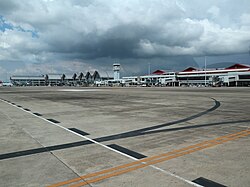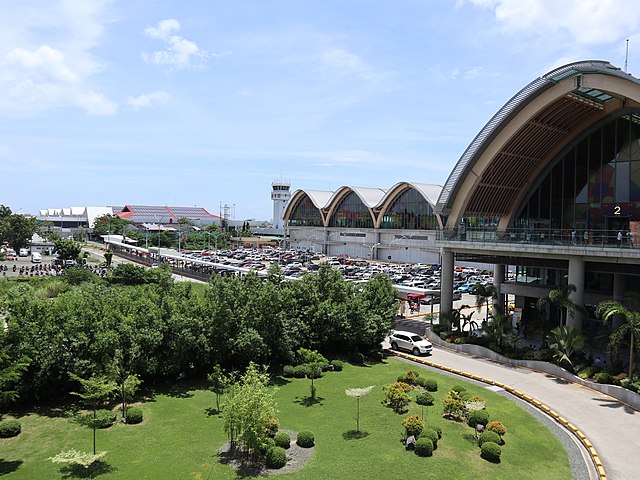Mactan–Cebu International Airport
Commercial airport located on Mactan Island, Philippines From Wikipedia, the free encyclopedia
Mactan–Cebu International Airport (MCIA) (IATA: CEB, ICAO: RPVM) is the main international airport serving Metro Cebu and serves as the main gateway to the Central Visayas region in the Philippines. Located on a 797-hectare (1,970-acre) site in Lapu-Lapu City on Mactan, it is the second busiest airport in the Philippines.[3] Opened on April 27, 1966, the airport serves as a hub for Philippine Airlines, and as an operating base for Cebu Pacific, Philippines AirAsia, and Sunlight Air.
Mactan–Cebu International Airport Tugpahanang Pangkalibutanon sa Mactan–Sugbo Paliparang Pandaigdig ng Mactan–Cebu | |||||||||||||||
|---|---|---|---|---|---|---|---|---|---|---|---|---|---|---|---|
 | |||||||||||||||
 | |||||||||||||||
| Summary | |||||||||||||||
| Airport type | Public | ||||||||||||||
| Owner | Mactan–Cebu International Airport Authority | ||||||||||||||
| Operator | Aboitiz InfraCapital Inc. | ||||||||||||||
| Serves | Cebu | ||||||||||||||
| Location | Mactan, Lapu-Lapu City, Cebu, Philippines | ||||||||||||||
| Opened | April 27, 1966 | ||||||||||||||
| Hub for | |||||||||||||||
| Operating base for | |||||||||||||||
| Time zone | PHT (UTC+08:00) | ||||||||||||||
| Elevation AMSL | 9 m / 31 ft | ||||||||||||||
| Coordinates | 10°18′26″N 123°58′44″E | ||||||||||||||
| Website | www | ||||||||||||||
| Maps | |||||||||||||||
 | |||||||||||||||
 | |||||||||||||||
| Runways | |||||||||||||||
| |||||||||||||||
| Statistics (2023) | |||||||||||||||
| |||||||||||||||
Source: MCIAA[2] | |||||||||||||||
The airport is managed by the Mactan–Cebu International Airport Authority and operated by the GMR–Megawide Cebu Airport Corporation.
History
Early years
The runway was built by the United States Air Force in 1956 as an emergency airport for Strategic Air Command bombers. It was known back then as the Mactan Air Base.[4] It remained a spartan outpost until the Vietnam War in the 1960s when it became a base for a C-130 unit of the U.S. Air Force.[4]
Commercial operations started on April 27, 1966[5] for domestic flights. It replaced the now closed Lahug Airport (now the site of Cebu IT Park) which could no longer be expanded due to safety and physical problems. International charter flights later commenced in 1978.[6]
On July 31, 1990, Republic Act No. 6958 was approved, which created and established the Mactan–Cebu International Airport Authority (MCIAA). The law transferred the existing assets and operations of Mactan–Cebu International Airport and Lahug Airport to the newly created MCIAA.[7]
Expansion
Plans for a new terminal were laid as early as 2005, but the expansion of the existing terminal was instead pursued. By 2009, the airport handled 4.8 million passengers, way beyond the capacity of 4.5 million. By 2017, the airport handled more than ten million passengers.[6]
The expansion of the airport was included on the list of big-ticket public-private partnership (PPP) projects as part of the PPP infrastructure program that was launched in 2010. Bidding was opened in 2012.[6] On April 23, 2014, the Department of Transportation and Communications awarded the operations and maintenance of MCIA to a consortium of the Philippine Megawide Construction Corporation and Bangalore-based GMR Infrastructure. The consortium won with a bid of ₱17.5 billion. MCIAA handed over the operations and maintenance of the airport to the private consortium on November 1, 2014.[8][9][10]
On June 29, 2015, President Benigno Aquino III led the ground-breaking rites at the site of the old Philippine Air Force base in Lapu-Lapu City which had been demolished to give way for the Terminal 2 construction.[11] Construction of Terminal 2 began on January 22, 2016.[12] On June 7, 2018, Terminal 2 was inaugurated by President Rodrigo Duterte,[13][14] with the terminal being operational on July 1.
On May 5, 2021, the second taxiway and expanded apron of the airport was inaugurated.[15]
Contemporary history
Following Typhoon Haiyan (Yolanda), one of the biggest typhoons ever recorded and one of the most destructive typhoons in the Philippines, the airport was used as a center for air operations for the relief effort. The airport is centrally located in the Visayas which was the region most affected by the storm, especially the Eastern Visayas islands of Leyte and Samar. The Cebu airport was relatively unaffected by the storm while the airports of the Eastern Visayas were unusable immediately after.[16]
On November 12, 2013, the world's longest and heaviest aircraft, the Antonov An-225 Mriya, landed at MCIA from the Zagreb International Airport in Croatia for the first time in the Philippines. It delivered a 180-ton replacement transformer from the Croatian energy company KONČAR for the First Gen Corporation's power plant in Batangas City. Officials of First Gen approached MCIAA General Manager Nigel Paul Villarete to allow the Antonov An-225 to utilize the airport for the transportation of their delivery after officials from Clark International Airport, Ninoy Aquino International Airport in Manila, and Subic Bay International Airport refused to allow the aircraft to utilize their airports.[17] According to First Gen President Francis Giles Puno, MCIA had been inspected by Antonov Airlines, the owner of the Antonov An-225 aircraft, as the most viable option for their aircraft, "after considering the combination of airport, onward land transport and sea freight."[18]
Philippine Airlines offered non-stop flights to Los Angeles, the longest route from MCIA, from March 2016 to May 2017.[19]
On August 27, 2018, on the occasion of National Heroes Day, President Duterte expressed support for renaming the airport after Mactan chieftain Lapu-Lapu whose forces killed Ferdinand Magellan during the Battle of Mactan in 1521.[20]
On December 16, 2021, the airport was closed indefinitely after sustaining heavy damage from Typhoon Rai (Odette) before resuming operations on December 19 under a new layout that integrates both terminals together since the domestic terminal sustained the most damage, while the international terminal only suffered minor damage.[21]
On September 2, 2022, Aboitiz purchased a 33.33% stake on GMR–Megawide Cebu Airport Corporation for ₱25 billion. In turn, GMR–Megawide issued ₱15 billion worth of exchangeable bonds in exchange for the remaining shares in GMCAC.[22] On October 30, 2024, it fully acquired GMCAC for ₱7.76 billion, thereby completely taking over the operations of MCIA.[23]
Future development
On May 22, 2017, Mactan–Cebu International Airport Authority (MCIAA) passed a resolution approving the proposal to start the construction of a second runway, which was proposed by Rep. Raul del Mar of Cebu. Del Mar proposed that the construction of the second runway be funded using P4.9- billion sourced from the P14.4 billion premium given by the GMCAC when it won the bid to develop and manage the MCIA terminal. Once completed, the second runway will be adjacent to the existing first runway and will enable simultaneous runway operations.[24]
The groundbreaking ceremony of the second runway was held on January 14, 2020.[25]
Terminals
Mactan–Cebu International Airport has two passenger terminals, with plans laid in 2019 for another terminal.[26]
| Terminal | Opened | Floor area | Handling capacity | Parking bays |
|---|---|---|---|---|
| Terminal 1 | 1990 | 38,525 m2 (414,680 sq ft) | 11.7 million passengers per year | 6 (aerobridge) 12 (remote) |
| Terminal 2 | July 1, 2018 | 65,500 m2 (705,000 sq ft) | 8 million passengers per year | 7 (aerobridge) 5 (remote) |
| Total | — | 104,025 m2 (1,119,720 sq ft) | 19.7 million passengers per year | 13 (aerobridge) 17 (remote) |
Terminal 1

Terminal 1, which was built in 1990, serves as the airport's domestic terminal. Prior to the completion and opening of Terminal 2, it housed both domestic and international operations and prior to its expansion, had an annual capacity of 4.5 million passengers,[27] before being increased to eight million following minor renovations from 2015 to 2016.[28]
The terminal has a floor area of 38,525 square meters (414,680 sq ft). It has six jet bridges and twelve remote parking spaces for aircraft. There are six baggage conveyor belts in the baggage claim area.[27]
GMR–Megawide Cebu Airport Corporation announced a two-phase renovation of Terminal 1 in December 2018 as part of its ₱17 billion investment to improve the terminals.[28] The renovation involved the expansion of the pre-departure area and improved flight information displays.[27] Manila-based architectural firm Budji + Royal Architecture + Design handled the renovation of the terminal, which was based on a resort-type design. One of its features is the Airport Village, which merges the arrival and departure areas to allow passengers to mingle within the airport. To facilitate its construction, the arrivals road was permanently closed. Renovations began in March 2019.[29] President Rodrigo Duterte inaugurated the newly rehabilitated Terminal 1 on January 19, 2020, increasing its capacity to 11.7 million passengers.[30]
Terminal 2


Terminal 2 is the newest airport terminal and has an annual capacity of eight million passengers.[31] Construction began on January 22, 2016, and was inaugurated by President Rodrigo Duterte on June 7, 2018, before opening to passengers on July 1.[13]
Integrated Design Associates designed the terminal with European timber arches from Austria that look like an inverted boat hull, and a wave-like roof that evokes a tropical and resort-like feel.[32] It represents the sea waves that surrounds the island of Cebu. Terminal 2 won an award for the category "Completed Buildings – Transport" at the World Architecture Festival in 2019.[33][34]
Occupying an area of 65,500 square meters (705,000 sq ft), the terminal has four check-in halls with 48 check-in counters in the departures area expandable to 72, seven jet bridges expandable to 12, 12 escalators, 15 elevators, duty-free shops, and a departure lobby.[27] The terminal's modular design allows for progressive expansion, with a fundamental building block structured for maximum adaptability to future development. Terminal 2 is exclusive only for international flights. However, due to the aftermath of Typhoon Odette, it was used for both domestic and international flights from January 16, 2022, until most parts of Terminal 1 were fully repaired by June.[35][36][37]
Structure
Runways
The airport has a 3,300-meter (10,800 ft) main runway (Runway 04R/22L) with a width of 45 meters (148 ft) that was built by the United States in 1956 as an emergency airport for U.S. Air Forces' Strategic Air Command bombers and was known as Mactan Air Base.[4] The runway is complemented by a full-length taxiway that it shares with the current Mactan Air Base of the Philippine Air Force.
The second runway (Runway 04L/22R) started construction in January 2020.[25] It is 2,560 meters (8,400 ft) long and 45 meters (148 ft) wide.[1] It was completed in January 2024. The runway serves as an emergency runway in case of major situations concerning the main runway.[38][39]
Other structures
The airport has other government buildings like the two-level CAAP Administration Building and the six-level MCIAA Corporate Building, both located within the airport complex.[15][40] The parking area outside the terminals has a total capacity of 750 cars.[27]
Airlines and destinations
Passenger
- Notes
- Emirates flights make an intermediate stop in Clark en route to the listed destination. However, the airline has no cabotage rights to carry passengers solely between Cebu and Clark.
- United Airlines flights continue to Los Angeles with the same flight number. However, there is an aircraft swap at the listed destination, switching from a Boeing 737 to a Boeing 787.
Cargo
| Airlines | Destinations |
|---|---|
| Air Hong Kong | Hong Kong[49] |
| SEAir International | Clark[50] |
| Skyway Airlines[51] | Clark, Davao |
Statistics


Data from the Mactan–Cebu International Airport Authority (MCIAA).[2][52]
| ||||||||||||||||||||||||||||||||||||||||||||||||||||||||||||||||||||||||||||||||||||||||||||||||||||||||||||||||||||||||||||||||||||||||||||||||||||||||||||||||||||||||||||||||||||||||||||||||||||||||||||||||||||||||||||||||||||||||||||||||||||||||||||||||||||||||||||||||||||||||||||||||||||||||||||||||||||||||||||||||||||||||||||||||||||||||||||||||||||||||||||||||||||||||||||||||||||||||||||||||||||||||||||||||||||||||||||||||||||||||||||||||||||||
Accidents and incidents
- On October 23, 2022, Korean Air Flight 631, an Airbus A330-300 with registration HL7525 originating from Seoul, overshot the runway after two landing attempts, shortly after landing in stormy weather. No injuries were reported, but the airplane was damaged beyond repair.[53]
References
External links
Wikiwand in your browser!
Seamless Wikipedia browsing. On steroids.
Every time you click a link to Wikipedia, Wiktionary or Wikiquote in your browser's search results, it will show the modern Wikiwand interface.
Wikiwand extension is a five stars, simple, with minimum permission required to keep your browsing private, safe and transparent.



